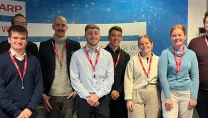As we look ahead to 2025, our teams have given their insights into what we can expect to come in the new year. This blog explores the key predictions for 2025, offering insights into how businesses can adapt and thrive in the face of these emerging trends across the IT, Tech, Print and Workplace Design sectors.
A year of getting the most out of what you’ve got
Mark Williams, Chief Operating Officer, Sharp UK
Despite AI hype, UK SMEs will be focused on making the most of their tools next year, ensuring they work better and more efficiently. We often speak to organisations and businesses that have licenses to a broad suite of technology and platforms that they just don’t use or get the most from. Reconfiguring, reimplementing, training and learning how to effectively leverage existing tools will help organisations and businesses speed up, get time back and do more with less. Many software solutions companies, like Microsoft, are embedding AI into their offerings, so SMEs will – at a basic level at least – be able to leverage emerging and advanced technology.
As driving efficiencies becomes more important in a changing economic climate, organisations and businesses will shift focus to making the most of their existing investments rather than chasing the next shiny innovation. With the rising cost of doing business, SMEs will look to reduce waste, streamline operations, and fully exploit the capabilities of the tools they already have. This approach will not only help them remain competitive but also position them for growth despite external pressures.
MSPs need to evolve – or risk their demise
Matt Riley, Data Protection and Information Security Officer, Sharp Europe and UK
The advancement of technology is outpacing human understanding. This is where the value of a great Managed Services Provider (MSP) comes into play, by helping to bridge the gap and bring people and technology together. Progressive MSPs are looking at the needs of SMEs holistically and are getting better at explaining risk and reward. This can, for example, mean helping them to understand the implications of security investments by explaining it through the lens of revenue protection. As a result, traditional IT companies that only fix broken tech will need to evolve or risk becoming obsolete. Managed Services Providers must become Technology Partners, strategizing, advising and delivering on all the tech the organisation needs to operate efficiently. As 2025 will no doubt see further leaps and bounds in terms of technology, prudent MSPs will be keeping pace.
Europe paves the way for AI regulation – but not just yet
Matt Riley, Data Protection and Information Security Officer, Sharp Europe and UK
The EU AI Act will provide quite a bit of transparency and protection for users of AI tools – but we’re unlikely to see any meaningful adherence to it until 2026 when AI providers will essentially be forced to comply. It’s for that reason that 2025 will be the year that people and businesses will be exposed to the most risk with AI tools. There are currently no real rules to what happens with the data we provide in exchange for the use of certain AI tools. This is much less of a concern for big players such as Microsoft, which provide structure, security and rigour to their offerings. But that’s not always the case for smaller, fringe AI companies or online service providers that leverage AI. IT leaders need to ensure they’re reading terms and conditions very carefully before approving the use of AI applications for work – or risk exposing their organisations and businesses to unknown entities.
Fighting fire with fire: SME cyber security levels up
Matt Riley, Data Protection and Information Security Officer, Sharp Europe and UK
Next-generation manage, detect and response solutions will become more readily available for SMEs in 2025 – which will enable far better cyber security thanks to the added layers and embedded AI capabilities. These security solutions have primarily been used by large enterprises, but thanks to many providers now distilling their solutions down into the SME market, we’ll see a much stronger security stature in smaller organisations. With cybercriminals leveraging AI adversaries and entirely new AI models launching in 6-month intervals, this cannot come soon enough.
2025: The year of deepfake AI
Matt Riley, Data Protection and Information Security Officer, Sharp Europe and UK
In 2025, deepfake AI will become a central tool in the cybercriminal playbook, with attackers leveraging increasingly authentic voice, video and image manipulations to deceive businesses. SMEs should prepare for a wave of highly targeted impersonation attacks, ranging from fraudulent financial transactions to breaches of sensitive data. The falling cost and accessibility of deepfake tools will expand their reach, threatening businesses of all sizes. As a result, organisations must adopt advanced AI-driven verification technologies, such as synthetic media detectors, biometric authentication, and blockchain-based digital watermarks - while fostering a culture of vigilance through ongoing employee training. Proactive investment in these areas will be critical to safeguarding trust and protecting against this growing wave of AI-powered deception.
Getting the cyber security basics right
Simon Jefferies, Director of Technology, Sharp UK
Security will become more of a priority for small businesses in 2025 – but this doesn’t necessarily mean heavily investing in the latest, greatest tech. Individual team members are the biggest security liability to an organisation but are also its first line of defence. As such, getting the basics right goes a long way. This is especially critical as cybercriminals today are not lone wolves. They are sophisticated business operations chasing multiple ‘business leads’ and are more than happy to conduct reconnaissance for a long period to identify gaps in a company to maximise financial gains. Phishing emails are key tools used by threat actors to gain access to a business and are getting increasingly authentic looking with the advent of AI. As a result, we expect to see more SMEs not only upping their cybersecurity training and awareness-building programmes to better arm their team against potential breaches, but also investing in AI driven cybersecurity tools if the human layer is breached.
Growing importance of environmental and security credentials
Kerry Rush, Product Marketing Manager, Sharp UK
Sustainability and security are two major considerations for organisations when it comes to a growing focus on due diligence across supply chains. In terms of technology, we'll continue to see environmental enhancements, such as recycled content in machines, recycled packaging, and lower energy consumption. At Sharp, we’re committed to reducing environmental impact and supporting our clients in this transition. We recycle and reuse parts considered waste and ensure safe, efficient, and secure disposal. This includes recycling consumables and using recyclable materials for product protection during transit. From a security standpoint, more organisations will look to suppliers for accreditations such as Cyber Essentials or ISO 27001 to validate and build trust, which is something we assist our clients in achieving.
A Further focus on inclusivity and Accessibility
Kit-Har Mclaughlin, Commercial Designer, Sharp UK
Inclusivity and accessibility are already big topics in the Workplace Design sector. Going into 2025, organisations are recognising the increasing importance of creating environments where everyone, regardless of ability, is welcome and comfortable. This means designing spaces that work and accessible for everyone, with features like adjustable desks. Additionally, there will be a greater emphasis on creating sensory-friendly environments, this could include quiet zones, adjustable lighting, and soundproofing to minimise distractions.
Sustainability in Workplace Design
Kerry Rush, Product Marketing Manager, Sharp UK
Sustainability is no longer a buzzword but a fundamental aspect of Workplace Design. In 2025, we can expect to see more offices incorporating sustainable materials and practices. This includes using recycled and upcycled materials, energy-efficient lighting, and water-saving fixtures. Biophilic design, which integrates natural elements such as plants and natural light, will be a key feature, not only to enhance aesthetics but also to improve air quality and employee well-being.
Flexible Furniture and Multi-Functional Spaces
Martyn Smith, Workplace Design General Manager, Sharp UK
The need for flexibility in the workplace has never been more apparent. The rise of remote and hybrid working models has driven the demand for adaptable office spaces. In 2025, we will see an increase in flexible furniture that can be easily reconfigured to suit different needs and working patterns. This includes modular desks, movable room dividers, and multi-functional furniture that can serve various purposes. This flexibility allows organisations to maximise their space and adapt quickly to changing work patterns.





